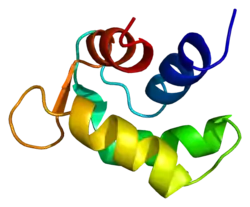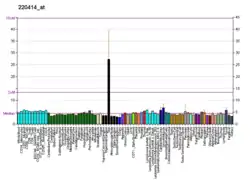CALML5
Calmodulin-like protein 5 is a protein that in humans is encoded by the CALML5 gene.[5][6]
This gene encodes a novel calcium binding protein expressed in the epidermis and related to the calmodulin family of calcium binding proteins. Functional studies with recombinant protein demonstrate it does bind calcium and undergoes a conformational change when it does so. Abundant expression is detected only in reconstructed epidermis and is restricted to differentiating keratinocytes. In addition, it can associate with transglutaminase 3, shown to be a key enzyme in the terminal differentiation of keratinocytes.[6]
References
- GRCh38: Ensembl release 89: ENSG00000178372 - Ensembl, May 2017
- GRCm38: Ensembl release 89: ENSMUSG00000033765 - Ensembl, May 2017
- "Human PubMed Reference:". National Center for Biotechnology Information, U.S. National Library of Medicine.
- "Mouse PubMed Reference:". National Center for Biotechnology Information, U.S. National Library of Medicine.
- Mehul B, Bernard D, Simonetti L, Bernard MA, Schmidt R (Jun 2000). "Identification and cloning of a new calmodulin-like protein from human epidermis". J Biol Chem. 275 (17): 12841–7. doi:10.1074/jbc.275.17.12841. PMID 10777582.
- "Entrez Gene: CALML5 calmodulin-like 5".
External links
Further reading
- Maruyama K, Sugano S (1994). "Oligo-capping: a simple method to replace the cap structure of eukaryotic mRNAs with oligoribonucleotides". Gene. 138 (1–2): 171–4. doi:10.1016/0378-1119(94)90802-8. PMID 8125298.
- Suzuki Y, Yoshitomo-Nakagawa K, Maruyama K, et al. (1997). "Construction and characterization of a full length-enriched and a 5'-end-enriched cDNA library". Gene. 200 (1–2): 149–56. doi:10.1016/S0378-1119(97)00411-3. PMID 9373149.
- Méhul B, Bernard D, Schmidt R (2001). "Calmodulin-like skin protein: a new marker of keratinocyte differentiation". J. Invest. Dermatol. 116 (6): 905–9. doi:10.1046/j.0022-202x.2001.01376.x. PMID 11407979.
- Durussel I, Méhul B, Bernard D, et al. (2002). "Cation- and peptide-binding properties of human calmodulin-like skin protein". Biochemistry. 41 (17): 5439–48. doi:10.1021/bi016062z. PMID 11969404.
- Strausberg RL, Feingold EA, Grouse LH, et al. (2003). "Generation and initial analysis of more than 15,000 full-length human and mouse cDNA sequences". Proc. Natl. Acad. Sci. U.S.A. 99 (26): 16899–903. doi:10.1073/pnas.242603899. PMC 139241. PMID 12477932.
- Gerhard DS, Wagner L, Feingold EA, et al. (2004). "The status, quality, and expansion of the NIH full-length cDNA project: the Mammalian Gene Collection (MGC)". Genome Res. 14 (10B): 2121–7. doi:10.1101/gr.2596504. PMC 528928. PMID 15489334.
- Rual JF, Venkatesan K, Hao T, et al. (2005). "Towards a proteome-scale map of the human protein-protein interaction network". Nature. 437 (7062): 1173–8. doi:10.1038/nature04209. PMID 16189514. S2CID 4427026.
- Méhul B, Bernard D, Brouard M, et al. (2006). "Influence of calcium on the proteolytic degradation of the calmodulin-like skin protein (calmodulin-like protein 5) in psoriatic epidermis". Exp. Dermatol. 15 (6): 469–77. doi:10.1111/j.1600-0625.2006.00433.x. PMID 16689864. S2CID 32717375.
- Babini E, Bertini I, Capozzi F, et al. (2006). "A structural and dynamic characterization of the EF-hand protein CLSP". Structure. 14 (6): 1029–38. doi:10.1016/j.str.2006.04.004. PMID 16765896.
- Ewing RM, Chu P, Elisma F, et al. (2007). "Large-scale mapping of human protein-protein interactions by mass spectrometry". Mol. Syst. Biol. 3 (1): 89. doi:10.1038/msb4100134. PMC 1847948. PMID 17353931.
This article is issued from Wikipedia. The text is licensed under Creative Commons - Attribution - Sharealike. Additional terms may apply for the media files.






